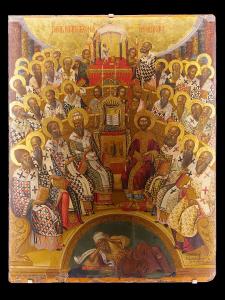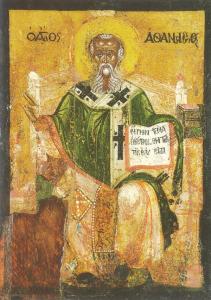Throughout my systematic theology class this semester, I ushered students into the painful process of learning theological terms. Like any discipline, theology has specific language (mostly Greek or Latin phrases, because we are pompous like that) which are used to describe certain ideas—once you learn the terms, you can understand the ideas espoused. So, for example, my students learn that the term aseity is derived from Latin phrase, a se which means “from itself”. This term is then employed to describe God’s complete sovereignty and absolute freedom; he is not dependent on anything.
Unfortunately, we sometimes miss an important distinction here—it is the reality expressed, not the words themselves, which are of the upmost importance. Now, don’t misunderstand me. Language is massively important and holds great power, as we can learn from feminist scholars and others—rhetoric matters. But, for the purpose of understanding positions, thoughts, and judgements, we foremost need to look at the referent that the words are pointing towards. Why is this? Because language is malleable. It develops, changes, and shifts in its cultural, political, and theological settings, as it seeks to describe realities. Terms often have a murky history— especially the term “homoousios.”
Famous Terms, Murky Definitions
One of the most pivotal periods in the development of Christian language about God was the fourth century. Amidst the various controversies about the Trinity, Christology, and Pneumatology, language was developed to articulate different theological positions. A famous example of this is from the Nicene creed, that the Son is consubstantial with the Father.
We believe “in one Lord, Jesus Christ the Son of God, begotten of the Father, the only-begotten, that is, of the essence of the Father, God from God, Light from Light, true God from true God, begotten, not made, of the same being as the Father, through whom all things came to be.”
The Greek term used here is homoousios, which literally translates to ‘same essence’ (from the Greek words homo and ousia respectively). While this term is now understood and discussed in a refined way by modern systematic theologians, the term was not always understood in such a nuanced sense. In fact, the meaning of this term is not fixed immediately at or after Nicaea—it was employed to achieve particular ends in a historically contextualized situation, later being expanded and refined.

First, it is important to note this term was rarely used by Christian theologians prior to the council of Nicaea in 325, and was certainly not centered in any way—in fact, the term was primarily used by Platonic philosophers to discuss how the human soul relates to the divine (see: Plotinus, Enneads 4.4.28), and by those who were condemned as heretics, such as the early Gnostics and later with those associated with Sabellianism. Decidedly not what the bishops meant at the council! But if no one really used the term homoousios before the council, who introduced it? If Eusebius of Caesarea can be believed, Constantine himself was the instigator: Constantine “advised all present to agree to it (the creed), and to subscribe and agree with its articles, with the insertion of the single word, ‘of the same being as (homoousios)’(Eusebius, Epistle to the church in Caesarea, 7). If this is the case, one of the most important terms in Trinitarian theology was introduced by a figure with no formal theological training, in a period of dramatic debate, without a significant Christian pre-history. A chaotic origin story, it seems (for more on this term, see: Pier Franco Beatrice, The Word “Homoousios from Hellenism to Christianity).
So why was this term employed at all? According to Athanasius of Alexandria, the bishops at Nicaea were trying to articulate a trinitarian theology that excluded Arius’ position (ontological subordinationism of the Son of God) using biblical language. Unfortunately, those associated with the ‘Arian theological position’ were happy and willing to accept any biblical term—they just had a different interpretation than the ‘Nicenes’ for each scriptural term. Thus, this term was introduced specifically to deny Arius’ own position. Athanasius writes, “But here too the (Nicene) bishops, beholding their (the Arians’) craftiness, collected from the Scriptures the figures of brightness, of the river and the well, and of the relation of the express Image to the Subsistence…and lastly they wrote more plainly, and concisely, that the Son was coessential with the Father; for all the above (scriptural) passages signify this (Athanasius, Ad Afros Epistola Synodica, 5). In other words, these bishops used this philosophical term to denote or describe a scriptural reality in clear and succinct language. At the council, the term itself was of little importance—it was used to exclude a theological position rather than to propose a robust Trinitarian theology. This is further seen by its employment immediately after the council: almost no one used the term for at least two decades, before Athanasius began to center Nicaea in his polemic against the Arians in the 350s.

So how might the bishops at Nicaea have defined the term before its significant discussion from the 350s onwards? For this, we turn to Eusebius of Caesarea, who explains his acceptance of the term in a letter to his church in Caesarea in 325:
“As this formula was being debated, we made sure to inquire in what sense they introduced ‘from the essence of the Father,’ and ‘of the same being as the Father.’ Through intense questioning and explaining, the meaning of the words was examined closely. They explained that the phrase ‘of the same being as’ indicated that the Son is truly from the Father, but he is not a part of him.” (Eusebius, Epistle to the church in Caesarea, 9).
Here and later in the epistle, Eusebius probes into the meaning of the term at the council and is given a minimalistic definition which denies materialistic overtones prevalent in neo-platonic uses of the term. He qualifies it in four ways: “(1) there is no materialistic division in the Godhead; (2) the Son is derived from the Father; (3) the Son is not a part or accident of the Father; (4) the Son is unlike creatures insofar as he is ‘of the same being’ as the Father” (Renberg, Is Eusebius a Nicene? 306). In sum, God is One and the Son comes from the Father in a unique sense without any division in the Godhead. Not exactly a fully fleshed out trinitarian theology! While some claim that Eusebius is intentionally distorting its original meaning, it seems more likely (given all the historical data above), that the term simply wasn’t well defined at the council itself. Thus, Eusebius accepts the term as defined above–it was used to subvert Arianism and only later was its meaning filled out.
Reading From vs. Reading On
In all of this, we must be mindful to look beyond a term to the judgement these writers are making, with all theological terms and positions. If we measured the orthodoxy of some of the major players at the Council of Nicaea—Alexander of Alexandria, Eustathius of Antioch, Eusebius of Caesarea—with this term alone, no one would measure up. But if we step back and probe into their theological frameworks, the referent for their theological vocabulary, we might round out our picture.
We (myself included) have a tendency in both historical research and modern discourse to hear a term and assume an entire position and framework around it—this is especially the case when it comes to trigger words, such as ‘evangelical’, ‘complementarian’, ‘woke’. Whatever someone means when they employ one of these terms, there is a wide variety of possible meanings and definitions that might accompany them. Now, I am not saying we abandon ship on certain terms (though, I find myself often using alternative terms to avoid confusion), but that we need to continue to develop the virtue of listening well here. As I go to texts in the fourth century that use theological terms such as consubstantial (homoousios/consubstantialitas), person (hypostasis/persona), or nature (physis/natura), I constantly need to remind myself to pause, focus on the broader concepts at play, and then make judgements about what they mean by these terms. When I import a large amount of data onto these terms in a historically conditioned moment, I often distort someone’s position. And I fear we might do the same with modern language that is used in diverse ways over misleading mediums. Let us cling to our terms, yes, but make sure we also consider the framework in which they are employed.













